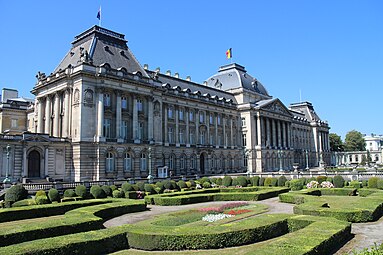
Royal Palace of Brussels
The Royal Palace of Brussels (French: Palais royal de Bruxelles, pronounced [pa.lɛ ʁwa.jal də bʁy.sɛl]; Dutch: Koninklijk Paleis van Brussel [ˈkoːnɪŋklək paːˈlɛis fɑm ˈbrʏsəl];[a] German: Königlicher Palast von Brüssel) is the official palace of the King and Queen of the Belgians in the centre of the nation's capital, Brussels. However, it is not used as a royal residence, as the king and his family live in the Royal Palace of Laeken in northern Brussels. The website of the Belgian Monarchy describes the function of the Royal Palace as follows:
Royal Palace of Brussels
1000 City of Brussels, Brussels-Capital Region
Belgium
1783
1934
33,027 m2 (355,500 sq ft)
- 1818–1820: Ghislain-Joseph Henry
- 1820–1825: Charles Vander Straeten
- 1825–1829: Tilman-François Suys
- 1868: Alphonse Balat
- 1903: Henri Maquet
- 1930–1934: Octave Flanneau
- Train: Brussels-Central
- Metro: Parc/Park (lines 1 and 5) and Trône/Troon (lines 2 and 6)
The first nucleus of the present-day building dates from the end of the 18th century. However, the grounds on which the Royal Palace stands were once part of the Coudenberg Palace, a very old palatial complex that dated back to the Middle Ages.[2] The existing facade was only built after 1900 on the initiative of King Leopold II.
The Royal Palace is situated in front of Brussels Park, from which it is separated by a long square called the Place des Palais/Paleizenplein. This area is served by Brussels-Central railway station, as well as by the metro stations Parc/Park (on lines 1 and 5) and Trône/Troon (on lines 2 and 6).
Royal Collection[edit]
In the Royal Palace, an important part of the Royal Collection is found. This consists of mainly state portraits and important furniture of Napoleon, Leopold I, Louis Philippe I and Leopold II. Silverware, porcelain and fine crystal is kept in the cellars used during state banquets and formal occasions at court. Queen Paola added modern art in some of the state rooms.
During state visits, the royal apartments and suites are at the disposal of visiting heads of state. Ambassadors too are received there with state ceremony. New Year's receptions are held for NATO, EU ambassadors and politicians. Royal wedding banquets take place in the palace, and after their death, the body of the deceased king lies in state there. If the king is currently in the country, the flag is hoisted on the central building. If he is present inside the palace, then the guard of honour stands at the front of the palace.
Surroundings[edit]
The adjacent park, Brussels Park, is separated from the Royal Palace by the Place des Palais. This rectangular park, measuring more than 13 ha (32 acres),[31] contains around sixty sculptures, primarily inspired by Greco-Roman mythology; two water basins with fountains; monumental neoclassical railings and gates; as well as two bandstands where numerous shows take place in the summer.[32] The middle axis of the park marks both the middle peristyle of the Royal Palace and of the Belgian Federal Parliament building (Palace of the Nation) on the other side of the park. The two facing buildings are said to symbolise Belgium's system of government: a constitutional monarchy.[33]



